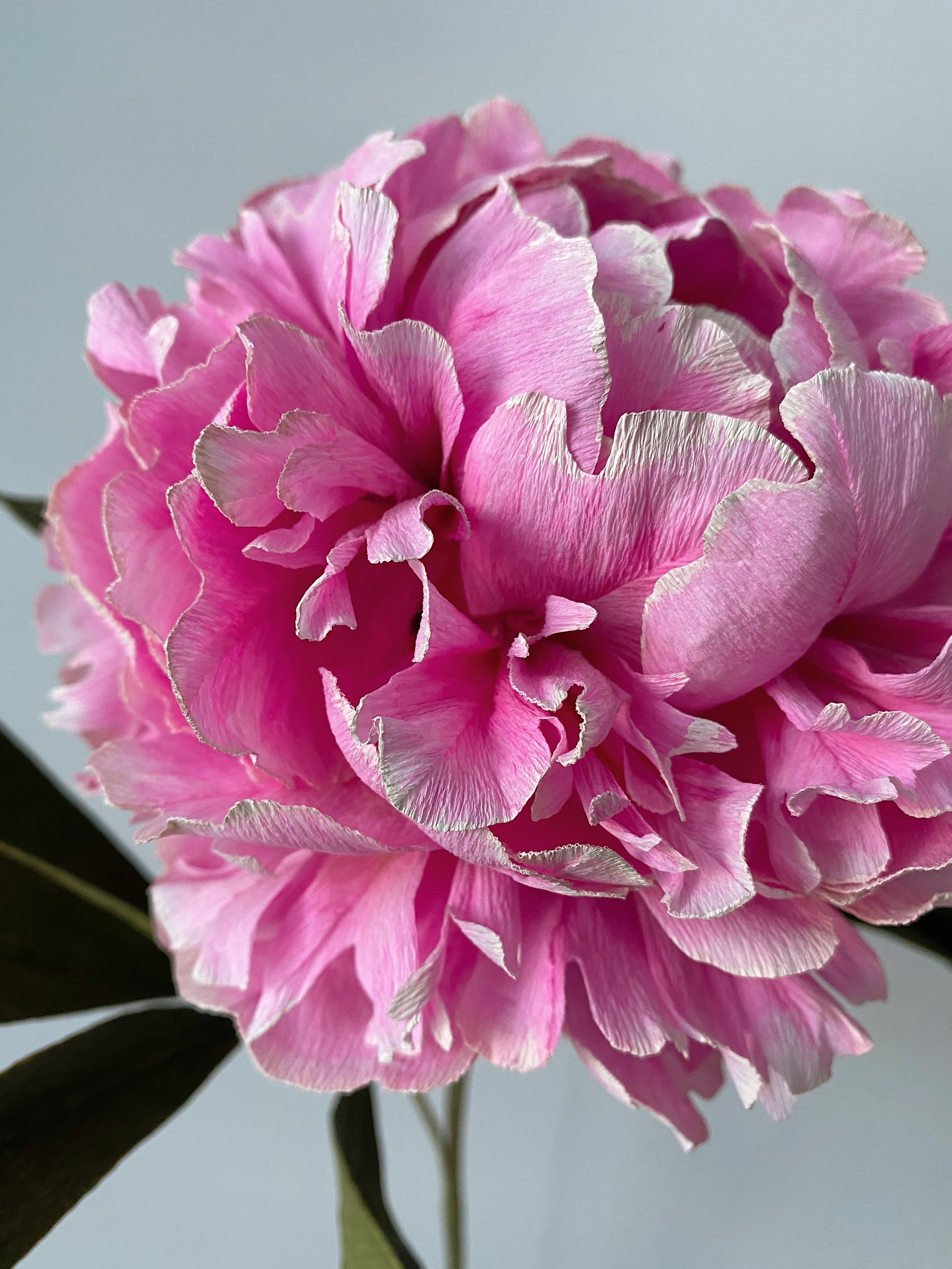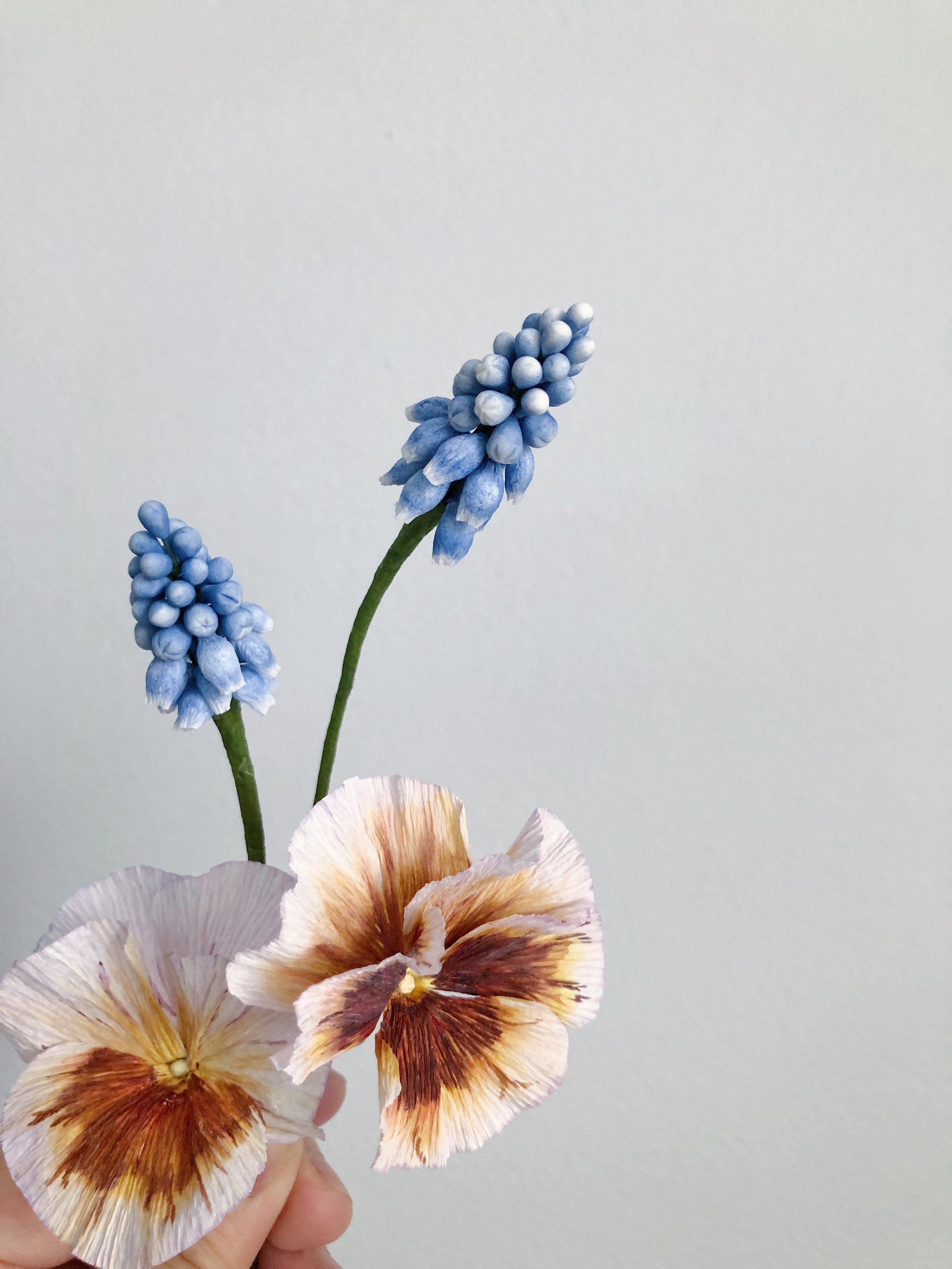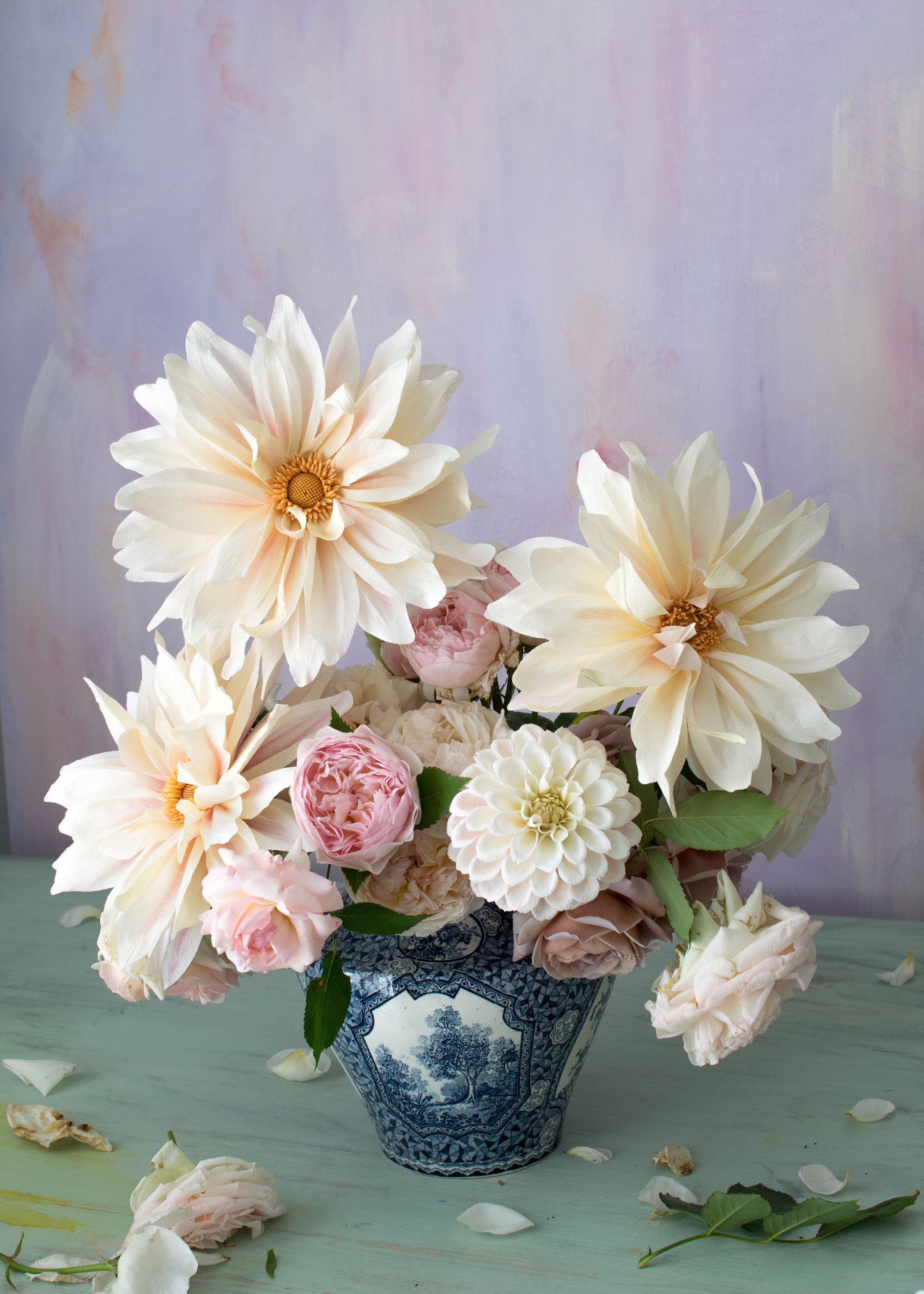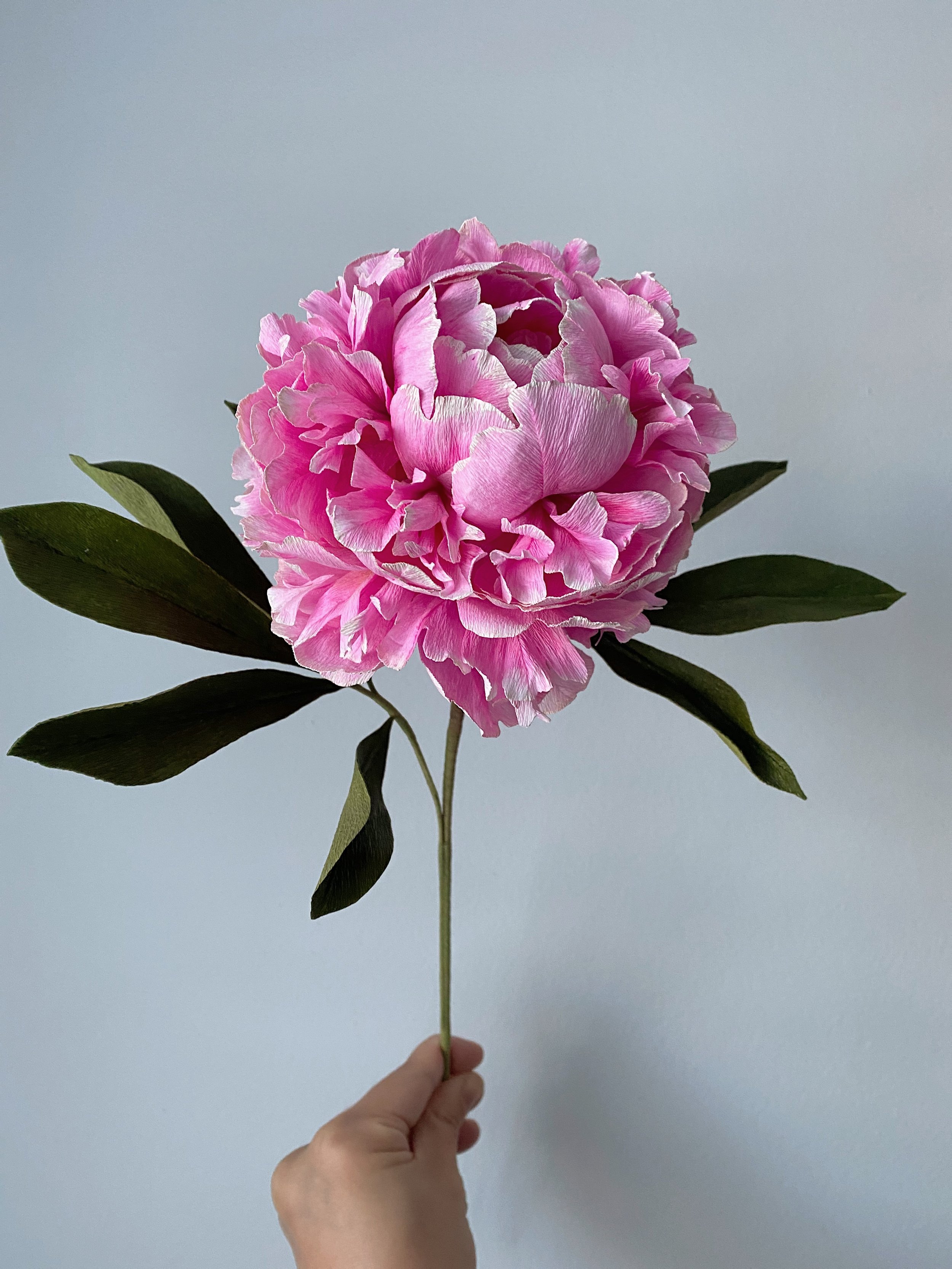How Sewing & Fashion Influence my Paper Flower Art
Double peony in bloom
Since I last popped in here, my baby - Cillian - has started solids, started crawling, and now, walking confidently! He turned 1 years old on Wednesday and he’s really starting to develop a personality. He’s busy exploring the house and insisting that his brother share all of his toys, including the one’s in Tristan’s hand (of course). Crawling hasn’t been as much of an adventure than when we started him on solids. After he had that first reaction to a peanut/tofu soup, I dreaded every time we gave him one of the top 8 allergens. After the fourth time in the Emergency Room and after staying overnight in the paediatric ward for monitoring, I decided enough was enough. I drafted an email to a large commercial project that I had been asked to involved in for the next two months and dropped the ball. I had to get my priorities straight. I decided I was going to finish off my existing commissions and take no further commissions with deadlines for the foreseeable future.
It’s been 3 months since I had been living in survival mood and I feel like a weight has been lifted off of my shoulders. I actually have time to think and reflect. I have more patience with my boys.
So the other day, I had the privilege of having a few hours to myself as Cillian napped. I watched a few documentaries, one of which was McQueen.
When I was in my teens, I aspired to be a fashion designer. I would watch Fashion Television religiously and I was always drawn to Alexander McQueen’s work. He is my absolute favourite fashion designer. Elie Saab and Marchesa round up my top 3. Although they all offer ready-to-wear, I always preferred their haute couture collections. I adored McQueen’s clever use of materials and impeccable tailoring. He made statements with each of his collections and he was bold and never apologetic. His art was raw and it came from a real place. His attention to the silhouettes he wanted to create was awe-inspiring. His pieces were strong but never unfeminine. He created pieces that shocked and then followed them with pieces that were completely wearable.
Admiring and evaluating the design of a garment - the tailoring, shape, feel, and look - is my comfort zone. I am drawn to the movement of silk chiffon draping the body, how the light hits black velvet to make it look like liquid metallic, the texture created by layers and layers of ruffles, the coolness of laser cut leather and softness of French lace, the intricacy of beaded embroidery on tulle. On reflection, I don’t know why I am surprised that I refer to terms often used to describe the characteristics of a garment when describing my own work. My pansy petals have “ruffles”, my dahlia petals have “collars”, and my parrot tulip petals have “frilly edges”. Unconsciously or consciously, I am inspired by haute-couture and I create details in my flowers and compositions and finish them in a way that reflect this inspiration.
Pansies with ruffled petals - Dahlia petals with collars - Parrot tulips with frilly petal edges
When I was in my teens and 20s, I was drawn to super tailored silhouettes, with defined lines that flattered my body. As a result of my particular tastes, I picked up sewing. Well, perhaps sewing chose me. In any case it was inevitable since both my parents sewed. My parents both come from families that were at some point, directly/indirectly involved in the business of fabrics and tailoring in Hong Kong. My mom’s father owned a shop that sold lining and interfacing. She would tell me stories about when she worked there; how she carried rolls of lining up flights of stairs; how their Japanese suppliers would downgrade the rating of their fabrics even for minor imperfection. She would tell me how the person who transferred the pattern onto the fabric was the highest paid because it required the most skill. When my cheap T-shirts started twisting after one wash, she would tell me how they intentionally misaligned the pattern on the grain line to save fabric. One of my earliest memories is of her sitting by the sewing machine and hemming our jeans.
My father’s father - my grandfather - worked at a high-end department store in the men’s suiting department. Back then, you could make a career out of it. Prior to that, he owned a few “start-ups”, one of which was selling custom tailored jeans (in HK, you can go into a shop to get measured for a bespoke 3-piece suit and delivered within 24 hours). My own father caught the tailoring bug in his teens and tailored his shirts so they were skin-tight and narrowed the seams of his jeans so they flared (it was the 70s). I have a strong memory of watching him reupholster a chair with a floral fabric.
Double pink peony
Perhaps it was watching my parents sew on a regular basis - sewing drapery, upholstering furniture - that I felt no hesitation trying to use it myself as a teen to create what I wanted in my head. I recall my first project - a side bag made from a swath of jean material (my parents had a lot of fabric samples; at one point, they had considered starting a business importing fabrics from Hong Kong with help from their contacts in that industry), a cross-body strap from a duffle bag, embellished with a red stuffed flower that had been a hair accessory. That began my journey into sewing. I wanted pants that created a slim silhouette (I was petite and the mass-produced pants created a bulge around my belly) with a flare (that was trending in the 90s), and doll and formal dresses that fit me properly. So I taught myself how to sew and bought books to learn more. I had an eye for beautiful fabrics and I liked to embellish just a little bit - not too much - just enough that it made that piece special. Later I would take a formal sewing and pattern making classes, however by then, I was already a lawyer.
Thinking about my experience as a sewer, I believe it helped me think and work in 3-dimension comfortably. And it shaped how I planned and executed everything. I first determined what I wanted the final result to look like, what are the characteristics that I wish to prioritize, then think backwards and forward to determine how to get there - do I need more darts? What fabric will work best with this shape? How do I reinforce the fabric so it stays stiff? How do I cut the fabric so it will drape with ease? What embellishment is needed to add more visual interest? Take this peony - I first nailed down the shape I wanted to create, determined which other flower I’ve mastered looks like it (a ranunculus), and then applying similar techniques, changed those techniques so they addressed one of the pressing issues of this flower: how to arrange the multitude of petals without them looking like a hot mess (by making sure there’s negative space between the petals).
One could say this is all too structured and that when it comes to art, the creativity should just flow, but I don’t believe that. If I learned anything in life - from my father (who is an obsessive planner), as a sewer, a half-trained graphic designer, and a former lawyer - it’s that executing refined results requires careful planning. . .





